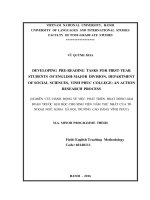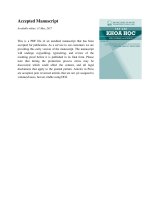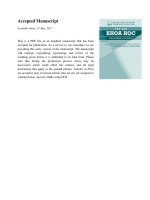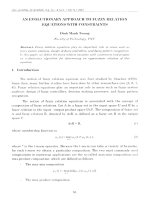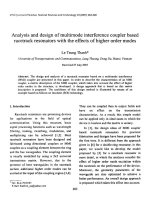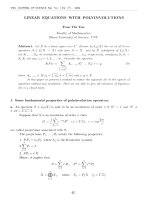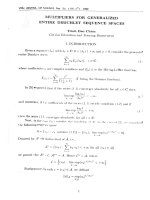DSpace at VNU: Spaces with Star-countable Quasi k-networks, Locally Countable Quasi k-networks
Bạn đang xem bản rút gọn của tài liệu. Xem và tải ngay bản đầy đủ của tài liệu tại đây (3.15 MB, 8 trang )
V N U . J O U R N A L OF S C IEN C E, M a th e m a tic s - Physics.
T.xx,
N()3 - 2004
SPACES W IT H STAR-COUNTABLE Q U A S I-A -N E T W O R K S ,
LOCALLY CO U N TA B LE
Q U A S I - A '- N E T W O R K S
T ra n V an A n
Vilih University, Nglic All
A b s t r a c t . Ill this paper, we introduce some kinds of network. <111(1 investigate till i-(»_
bitionships between them. Also, it is proved that the pseudo-open .s-ima^e of cl Fi-(vh(ii
space having a locally countable k -network is a Frechet space so doing.
1.
In tro d u c tio n
Spaces having star-countable A>networks, locally countable fc-networks have (onsid em i by Y. Ikeda and Y. Tanaka in [2], In that, paper, the authors have studied r!i,
M'lationships among spaces with star-countable A:-networks, spaces with locally countable k-uvtworks. They have prescuitetl characterizations OÍ spaces with st;ir-count.ihl(
/,■-net works, and spares with star-countable closed /.--networks. Also, the authors lLav(
shown that lor sonic rippr<>priiitt' conditions, spaces with stai-cou ntab lr A:-networks (<)1
spal l's with locally countable Ả:-iH'tworks) arc preserved by closed maps .
Ill this papiT we deal with a spaces having star-countable quasi-/,:-iK'twoiks. loialh
count
c w o r k s . stm -rouut al)l<‘ k -net works, and locally countable k-lK'twaics
consider relationships among those1 notions, and prove that a Iurchi't spare with a liKalh
countable /.-network is preserved by pseudo-open .s-map.
\ \ v assume that spares are regular T\, and maps are continuous and onto.
Lot X he a topological space, and lot V be a cover ot X .
'P is a k-network, if whenever h c Ư with A compact and u open 111 A ,
1 1 . D e f in itio n .
hoi
I\ c U T
c u for n certain finite collection T c V.
V is a stnmy-k-network, if wliiiiicrvcr K c u with K is compact and u is optn ii
A’, tilt'll there is a finite colletion F c v such th at for ('very F e T th en ' exists a cl)S('<
set C ( F ) c F satisfying K c
u
C(F) C U T c u .
1.2. D e f in itio n . Let V be cl cover of X .
V is calk'd a quasi-k-nctwork. if whenever I\ c u with A is ((mut ably C
open ill X , thon K c u f c
u for a crrtain finite' collection T
c V.
V is called a st.nmy-quasi-k-network if whi'iK'Vcr K c u with A is (■(nuital)l;
com part V. and Ư is open ill X . then there is a finite collet ion F c V such that tor
Ị^J C ( F ) c U-77 c I .
FeJ-
A cover V of X is said to he locally countable, if for every X G X li.'i
is a iH'iKlilK.urhoocl V of X such that V meets only countable m any members of V.
1 3. D e f in itio n .
Typeset by -ẠậẠ-TÈ
29
Tran Van A n
A cover V of X is said to be point,-countable, if every X e X is in at most count ably
many elements of V.
V is said to be star-countable, if every p e V meets only countable many members
of V.
A cover V is said to be closed (open), if every sot p 6 V is closed (respectively,
open).
1.4. D e f i n i tio n . A topological space X is said to he determ ined by (I covar'P (or X lifis
the weak topology with respcct to V ), if a set E c X is open (closed) ill X if and only if
E n p is open (resp. closed) in p for every p e V .
A topological space X is called a k-space, if X is determ ined by the cover consisting
of all compact subsets of X .
A topological space X is called a quasi-k-spacc. if X is determined by tile-' cover
co n sistin g o f all c o u n ta b ly c o m p a c t su bsets o f X .
A topological space X is said to be Frcchct, if for every A c X and r E ~4 th(‘i(‘ is
a sequence
c A such th a t x n —» X.
1.5. L e m m a .
Let X be a topological space, and Y c X .
quasi-k-network (k-netw ork), then so does Y .
Proof. It directly follows from the definition.
Ij X has a locally countable
[3, Lemma. 1.1] Let V be a star-countable cover o f X . Then we have
1. X is a disjoint union o f { X Cy : CY G A}, where cach X (Yis acountable union
elements o f V .
1 .6 . L e m m a .
2. If X is determined, by V , than X is the topological su m o f the
A} i'll (1). and the rover V is locally countable.
of
collcction { X n : CY G
1.7. P r o p o s i t i o n . [3, Proposition 1.7] Let X be a Frachet space. Then the followiuy arc
equivalent.
a.
b.
X
has a star-countable (dosed k:-network;
X is a locally separable space with a point-countable
h-network.
L e m m a . [6 , Corollary 2.4] Every k-spacc. with a star-com liable k-network is a
pavdcompact Ơ-space.
1 .8 .
1.9. T h e o r e m B a l o g h . [2, Theorem 4.1] Every countably compact space with pointcountable quasi-k-network (or k-netw ork) is metrizablc (and thus, compact).
2.
T h e m ain re su lts
Firstly we present some relationships between a locally countable quasi-Ẳ:-ii('twork.
a locally countable strong-quasi-fc-network, a locally countable closed quasi-Ả:-ii('twork. c\
locally countable A-ii(‘twork. find a locally countable closed Ả>iK'twork.
2.1. T h e o r e m .
a. X has a
I). X
c. X has a
Let X
locally
has a
locally
be a topological space. Then the following arc equivalent
countable stronq-quasi-k-nctwork;
locally countable quasi-k-network;
countable dosed quasi-k-network:
31
Spaces w i t h s t a r - c o u n t a b l e quasi-h - n e t w o r k s , .
(1. X
(’. X
has a locally countable Ả-network;
It (IS a locally com liable, (dosed A:-network.
I
Proof, (a) => (b) is obvious.
(1>) => (c) Lot V ' be a locally countable quasi-Ả> net work. D(‘H()t(‘ V — { P
:
p GV ) .
Them V is a locally countable closed quasi-Ẳ:-iietwork. Iii(l('('(l. lot K be a
countahly compact subset, and u ail open subset such th a t A c u . Sincí' X has a
locally countable quasi-Ar-network. by Lemma 1.5 A also lias a loc ally countable quasi-Ả;lK'tvvork. From T heorem Balogli, it follows that A is com pact. For ('V(TV ./• G A . (k'liotr
i r , nil o p rn neighbourhood of X such th a t X G VÍ.X c W x c u . T h e n th e collection
{ H : .r G A”} covers / \ . As A' is com pact, there exists a finite subcollection W \ i . . . , w s
s
so that /\ c M Wj. Because V is a quasi-fc-network, there is a finite collection T c V
7-1
such that K c u f c [ j Wi. It implies th a t K c U { ^ : r> e F ) c Ị J
c u.
i=\
i=l
_
It is easily seen th a t if \ 4 is ail opc'11 neighbourhood of X such t hat V:r n p Ỷ (p f°r
SOIIK' p € V ' . then K r n r / 0 .
Thus, f r o m t h e ' l o c a l c o u n t a b l i t y of t h e ' c o l l e c t i o n V . it
follows that the collection V is so locally countable.
(c) => (d)
is obvious.
(cl) => (e) Assume' V ' is a locally countable Ẳ>network. Lot V — { p : p € V ) . I lion
V is <\ locally countable elosrcl A;-network. Ill fact, suppose' th a t K is com pact and u is ail
any open such th at K c u . For every r e K by W x we deno te an open lK'i^hbourhood
of ./• such t hat .r £ w ,. c IV|: c u . T h e n the collection {IV,: : .r E A } covers A . Because
.s
I\ is compact. there is a finite collection W \ , . . . , VKs so t h a t A c I J Wj . Silico V is c\
1=1
s
quasi-Ả;-iK'twork. there exists a finite collection T c V ' such t h a t K c U T c [ J Wj. It
i=i
follows that /v c U { ^ :
e .T7} c Ị J W" c Í/.
2— 1
By using the m etho d as ill the proof of implication (b) => ((•)* it follows t hat V is
ri l o c n l l y c o u n t a b l e .
((») => (a) Assume t hat X has a locally countable closed ^-netw ork V . Them by
Tli('()i(‘in Bcilogh. ci subset A of X is countably compact if and only it A is compact.
Therefore follows that. V is a locally countable quasi-fc-network of X .
2 2. L e m m a . Let X be (I space having a locally countable quasi-k-network. Then
1 For every X G X there is a neighbourhood V with the following properties
(a) Every open set w c V is a countable union of d osed subsets;
(I)) V is Lindclof.
j 2. Every X G X is a Gs-set.
Proof. 1) Assume th a t V is a locally countable quasi-fc-network. By the proof of T heorem
9 [
collection V — ( p : p € V ' } is a locally countable closed quasi-k -network. Hence
for every X € X there is ail open neighbourhood V of X such t h a t V m eets only countable
T r a n Van A n
many d elim its of V . Denote* Vr — {Q € V : Q c V } . It follows tluit V r is cl countr\hlv
collection and V — u { ợ : Q G V j }. Thus (a) is proved.
L(‘t u he ail any open cover of V . For every y E V there exists u G u such that
tj E u . Since V is a locally countable quasi-fc-network in X , th ere is a
Q
G V satisfyi
IJ G Q c u n V . As shown above, the collection Vx — {Q €. V : Q c V}
is
countable,
V = u { ợ : Q G V , } • For each Q G ‘P;,;, put an ƯQ G
such that. Q c ƠQ. T h ru the
family U v — {U q E U : Q G p., } is a countable cover of V. Hence K ivs Lindclof.
2) Lot X bo ail any point in X . By assertion (1) there exists a neighbourhood
V of ./• such t hat ('very open subset of V is a countable union of closc'd subsrts. H(' 11C(\
X
\v<* luivr V \ {./•} =
Ek- when'
is closed for i'cieli k = 1 , 2 . . . . .
It follows tlirif
k=i
X
{./•} — 1^1 (V \ £ ’/, ). Thus, the set {./•} is a GVs('t\
A- 1
\ Y ( ‘ 1H)\V c o n s i d e r SOUK' r e l a t i o n s h i p s b e t w e e n a l o c a l l y c o u n t c i b l r q u a s i - Ả : - i i ( ' t w o r k .
i\ rr-l()Ccilly finite closed Lindolof1quasi-A:-network. a star-cou ntab le closed qUfUsi-A:-ii(‘twork
i1lid a star-countable quasi-A:-network.
2.3. T h e o r e m . For an any topọlogical space X , and the following conditions (a) — (d)
W(ã. have (a) or (b) => (c) => (d).
a.
X ha.fi a locally countable quasi-k-network:
I).
X has a Ơ-locally finite (dosed L êiiulelof quas'i-k.-network;
c.
X has a star-countable dosed quasi-k-network;
(L
X has a star-count able quasi-k-network.
*x.
Proof.
(b) => (<•). Assume that V
Ị^J v„ is c\ rr-locally finite closi'd Liii(l('l()f quasin= l
//-artwork. It is only sufficient to Ị)H)V0 that V is a star-countablr. Iii(l('('(l. put any
p € V. Siller V is iT-locally finite*, for ('very ./• E p . ami for ('VC1 V n G iV th('i(' rxists
f\ lH'ighljouihood V " of ./• such that V " moots only finite' m any eh'UK'iits Q G v „ . Th('
colli'cl ion {V " : .r G p } is a C()Y(T of p . Bocausp p is Lindi'lof. th('i*(' C'xists f\ C()iuital)l('
sul)C()ll('('ti()u {V," } ^ =:1 covering I \ As (‘very set V " iiKX'ts only finite many ('h'liK'iits
Q ^ VtỊ. p moots only countable inany olcinonts Q G v „. T hu s p moots only count al)l(‘
m a n y (‘l o i i K ' i i t s o f V .
((■] => (d)
is trivial.
Now we prove th a t (a) => (c). Assume th a t V' is a locally countable ({1UUSÍ-ẢlK'twork. By the proof of T h r o m n 2.1. the colloct.ion V — { p : p G V' } is M locally
countablr closed qiuisi-A>network. Honco for overy X 6 X there is an open lK'ighhonrliood
V’, of./• such that V, liKM'ts only countablr m any rlciiH'iits of V. By Li'inniM 2.2 V, is
Lindi'lot. p u t V* — { P 6 V : p is emitaiiK'd ill V, for some X € X } . TIk '11 V* is i\locally
couiit;il)l(‘ closed Liii(l('l()f qiuusi-A:-iiOt\V()ik.
Ill
frict. SÌIICÍ' p* is a svil)coll('c tioii of the loc ally countable collection V. V* also i
locally coiintahli'. M omivcr. ('V('iy Q G V* is a closc'd suhs(‘t of a ( ('ltain Lilidi’lof space
\ . hrncr Q is Lindolof. Now W(' J)H)V(‘ that V* is rì (Ịiuỉsi-Ẳ'-ii(‘twoi k. L (‘t A 1)(‘ countahly
33
S paces w i t h s t a r - c o u n t a b l e q u a s i - k - n e t w o r k s , .
compact, and u ail any open set such t hat K c u . Sincí' X has a locally countable closed
quasi-Ả:-network V , by T h eorem Bi-i log'll K is compact. For any X G K , by V:r we denote an
<)Ị)(H1 neighbourhood of X such th a t V-r m eets only countahlc' elements of V, and W'";,. ail open
lK'i^hhourhood of X such th a t X G vv.r c W x c V;, n Í / . T h e collection {IV,. : ./: G A } IS an
oprii cover of K . Because I\ is com pact, there exists a finite subcollection W r i , . ■• , vv./m
in
such th at /\ c
H v * For every i = 1 , . . . , m. put A'./ = K n tỵ ,.,. Thon A, is ail
(•(mutably compact, set in VXi, 1 = 1 , . . . , m. Since p is a locally countable closed quasi-AtlK'twork. for every I = 1 , . . . , m there is a finite collection {Pij : j
=
1, . .
•
,n»}
that K, c M P-ij c 14 . T h u s th e collection T - {Pij : i = 1, . . . ,m: j = 1, . . . , n,} c p*
j= i
is a finite subcollection of p * satisfying K c UJ* c u .
Since every Q € p * is Lindelof, p * is a locally countable quasi-fe-net.work. by using
the argum ent p resented in th e p ro of o f th e im plication (Ò) => (c) it follows that p * is
stfi 1-n mutable.
2.4. C o r o l l a r y .
I f X is a k-space, then the following arc equivalent
a.
X has a locally countable quasi-k:-network;
b.
c.
X has a locally countable k-network;
X has a star-countable closed quasi-k-network;
(I.
X has a star-countable closed k-network;
X has a Ơ-locally finite closed L i n d d o f quasi-k-network;
f.
X has a Ơ-locally finite L indelof quasi-k--network.
Proof,
(a)
(b) It follows from T heo rem 2.1.
(a) => (<••) It implies from T heorem 2.3.
(r) =^> ((/) is obvious.
(r/) => (e) A ssum e th a t X has a star-countable closed k -network V . Denote
V* a eolk'ctioii of all finite unions of elements in V . Then V* is also a. star-countable
closed k -network. Since X has a star-countable closed Ả>network, by Theorem Balogh
r v o i y ( ( m u t a b l y c o m p a c t s u b s e t o f X is c o n t a i n e d i n a c e r t a i n e l e m e n t o f V * .
by
assum ption yC
(\ Ẩ‘-SỊ)HC(' it follows tlifit s£ IS (lotoimiiK'd l)y 7^ 13v L( 111111ri 1.0(h).
oc
X b rin g c\ topological sill'll of { X a : a G A}, where Xct —
Patni
^ ^
^()1
7 7 -1
(\ e A,// € iV. and V* is star-countable.
It is similar to the proof of the im plication (a) => {(•) in Theorom 2.3, it follows that
Pn
is Lincli'lof for all (V G A, n G i/V.
Vn = { P a n : a G A}. T h e n we got p* = Ị J Pu with p„. is a locally finite
n= 1
collection for all n G -ÍV.
(e) => ( / ) is trivial.
( / ) => («) A ssum e t hat X is a k -space having a fT-locally finite Lindelof quasi-fcPut
lK'twork V. By using th e proof presented in the implication (6) => (c) in Tlicoicrn 2.3 it
follows that V is star-countahle. As ill the proof of (r/) => (e) we get
that X is cl('tcnniii('(l
c
34
T r a n Van A n
by V. Therefore, by applying Theorem 1.6(b) it follows th a t V is locally countable.
2.5. D e f in itio n .
A space X is said to be cj-compact if every countable subset of X have'
ail accum ulation point.
2.6. T h e o r e m . Let. X be a spare. Then the following arc equivalent
a. X is compact metric;
b. X is an UJ-compact spo.ee having a locally countable quasi-k-network;
X is an OJ-compact first-countable space having a star-countable quasi-k-nctwovk;
(I. X is a countably compact space having a point-countable quasi-k-network.
Proof, (a) => (b) is obvious.
(b)
=> (f). It follows from Theorem 2.3 t.hat. X has a sta r-c o u n ta b lr quasi-k-notwork.
Put any X 6 X . Because X has a l o c a l l y countable quasi-k-network, by Lemma 2.2 every
point of X is a GVset. Hence there exists a sequence of closed neighbourhoods {V,,} of
./• such th at Vn+1 c Vn for all n > 1, and {x} = ị | vn. We shall prove th a t for every
neighbourhood u of X there exists vn such th a t vn c u . Conversely, assum e Vn <£ u
for all 11 > 1. Then for every n > 1 there exists x n G Ki such t h a t x n ị u . Siller Ar is
uMompact. the set
: n > 1} have an accum ulation point y. Because x , n G v„ for all
m > n. and
v„ is closed,
it implies th a t y G
vn for
all n > 1. It follows flint IJ G
vn.
Hrncr tj = ./• 6 Ơ. On the other hand, as y is an accum ulation point of
://>!}.
there exists
G u . This is contrary to the choosing the sequence {;i:n } so that ./■„ ^ u
for all n > 1. Thus the collection {Vi,.} is a countable neighbourhood base of X. and X is
first-coiuitabli'.
(c) => (d). It follows from that a first-countable CJ-compact space is counta.l)lv
compact, and a star-countable quasi-k-network is a point-countablo quasi-k-ii('twork.
(d) => (a). It follows from Theorem Balogh.
2.7.
D e f in itio n . A m ap / : X -» Y is pseudo-open if, for each y G Y , IJG l n t f ( U)
whenever u is an open subset of X containing
2.8. P r o p o s i t i o n . [5, Theorem 5.D.2] I f f : X —> Y is pseudo-open, and X is a Frc.chct
space, then so Y is .
2.9. D e f in itio n .
A m ap / : X —> Y is a s-m a p if f ~ l (y) is separable for each y G Y .
2.10. L e m m a .
spacc.
[1, Corollary 5.1.26] Every separable paracornpac.t spare is a Lindclof
2.11. L e m m a . [1. Corollary 3.1.5] Let u be an open subset o f a spacc X . I f a fam ily
{F s }S£ s o f closed subsets o f X contains at least one compact set. - in particular, i f X is
compact - and if P i Fs c u , then there exists a finite set
111
2.12.
{.S i,...
, .s „,}
c s such that
s£S
P ro p o sitio n .
Let X be a space having a locally countable quasi-k-network. I f X
Spaces w i t h s t a r
-
35
countable quasi-k-netw orks,.
is UJ-compact, or X is a locally compact space, then X is a first-countable space.
That
means that X is a Frechet space.
Proof. If X is GJ-eompact. then from the proof of (6) => (c) ill Theorem 2.6 it
follow s t h a t
yY
is f i r s t - c o u n t a b l e .
Assume now th a t X is a locally com pact space, and X is an arbitrary point ill X .
Brea use X has a locally countable quasi-k-network, by Lemma. 2.2 every point of X is
a GVsct. Hence, there exists a sequence of com pact closed neighbourhoods {Vri) of X
oo
such th a t V„ +1 c v„ for all n > 1, and {x} = P i Vn . Assume th a t u is an any open
neighbourhood of X, i.e {;;•} =
oo
P i Vn c u .
71
=
71=1
From Lemma 2.11, it follows th a t there
1
exists a neighbourhood Vn such that. v n> c u . Thus the family {VỊi} is a countable
neighbourhood base of X, an d X is a first-countable space.
2.13. P r o p o s i t i o n . [2. T heorem 7.1 .(g)] Let, X be a Frcchct. .space with a point-countable
k:-network. I f f : X -> Y is a quotient s-m np, then Y has a point-countable k-network.
2.14. T h e o r e m .
Let f : X -> Y be a pseudo-open s-map. I f X is a Frechet space having
a locally countable k-netw ork, then so docs Y .
Proof.
As if is well-known, every Frechet. space is a fc-spa.ee, by Proposition 1.7. and
Corollary 2.4 ill Older to prove Theorem 2.14, it is sufficient to show th at if X is a Frochot
space with a locally countable fc-nctwork, f : X -> Y -A pseudo-open .s-map, then Y is a
Frc’clu't space having a star-co u ntable closed fc-network.
Indeed since X is Frechet, an d / is pseudo-open, it follows from Proposition 2.8 th at
Y is a Frcdiet space. Since every locally countable k -network is point-countable, and every
pseudo-open m ap is quotient, by Proposition 2.13 we get t h a t Y has a point-countable
A:-no'twork.
As every Frechet space is a fc-space, and X has a locally countable A;-network V.
by Lomma 2.4 and Lem m a 1.8 X is p aracom pact. For each LJ € Y , since' / is a s-map.
f ~ l (y) is a separable closed subset of paraconipact space X . By Lem m a '2.10, it follows
that / _1(.ự) is Lindelof. Put. any 2 6 / _ 1 (y). since V is a locally countable fc-network in
A", by Lemma 2.2 there exists an open Lindelof neighbourhood Vz of 2 such th a t v z meets
only countable m any elements of V. T h e family {V, : z € / 1(y)} is 311 open cover of
f~ [(y). Because
is Lindelof, there exists a countable family {VZu : n > 1} covering
Denote u = M V-„. we have f ~ l (y) c u , and by the proof of Loinma 2.2 if
n = l
___
follows th a t the collection Q = _ { p G V : p c u ] is countable, and u = u { p : p e
For each p 6 Q take Xp € p . T h e n th e set A = { x p : p G Q} is countable,
"4 = u . Denote D = f ( A ), th en D is countable. Because / is continuous it implies
~B = f ( U) . A nd since f is a pseudo-open m ap, we get y 6 l n t f ( U) . Thus f ( U )
Q}.
and
that
is a
separable n eig h b ou rh ood o f y.
Hence, Y is a locally separable Frechet space with a point-countable k-network. By
Proj)osition 1.7 Y is a Frechet space having a star-countable closed k-network. It follows
from CoroUuy 2.4 t hat Y is H Frechot space with a locally countable fc-network.
T ran Van A n
36
Since every Frechet space is a k-space, by Corollary 2.4 an d T heorem 2.14 we obtain
2.15. C o r o lla ry .
Let f : X —> Y be a pseudo-open s-m ap. I f X is a Frechet space
satisfying the one of the following
a. X has a locally countable quasi-k-network;
b. X has a locally countable k-network;
c. X has a star-countable closed quasi-k-network;
d. X has a star-countable closed k-network;
c.
X has a Ơ-locally finite closed L indelof quasi-k-network;
f. X has a a-locally finite Lindelof quasi-k-network
then so Y has vcspecMvely.
From the latter, Proposition 2.12 an d T heorem 2.14, we have
2.16. C o r o lla ry .
Let X be a space having a locally countable quasi-k:-network, f :
X —» Y a pseudo-open s-map. Then each one of the following (a)-(d) implies that Y ha*
a locally countable quasi-k-network
a. X is an u-com pact space;
b. X is a locally compact space;
c. X is a first-countable space;
d. X is a Frcchet space.
R eferen ces
1. R. Engelking, General Topology, PW N-Polisli Scientific Publishers, Warszawa 1977
2. G. Gruenhage, E. Michael, and Y. Tanaka, Spaces d eterm ined by poiiif-countabli
C()V(US, Pacific J. Math., 113(2)(1984), 303-332.
3. Y. Ikeda and Y. Tanaka, Spaces having star-cou ntab le k-networks, Topology Procccdinfj. 18(1983), 107-132.
4. S. Lin and Y. Tanaka. Point-countable k-networks, d o s e d m aps, and related results
Topology and its A p p l , 50(1994), 79-86.
5. E. Michael, A quintuple quotient quest, General Topology and AplL. 2(1972). 91138.
6. M. Sakai, Oil spaces with a star-countable fc-network, H ouston J. Math., 23(1
(1997), 45-56.
7. Y. Tanaka, Point-countable covers and k-networks, Topology Proceeding, 12(1987)
327-349.
